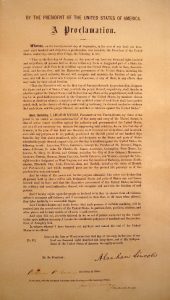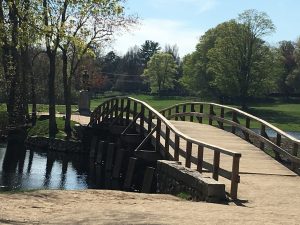In our previous post, we examined some of the current discussion around reparations for slavery. Many factors are coming together in our society that make it apparent that our “original sin” of slavery still has serious ramifications more than 150 years after the Civil War, ramifications that need addressing sooner rather than later because of the current divisive climate in our nation, especially around race. It is also vital to understand that the tragic legacy of slavery affects all of us in the US, not just blacks and other persons of color. 
Here we will highlight two related results of slavery that must be acknowledged and addressed – the so-called “Lost Cause” narrative or mythology and the issue of Confederate monuments and statues – and honor some of the states, cities and organizations that are finding ways to celebrate and memorialize different, more inclusive values. (We should also note that there are monuments and memorials throughout the US, not only in the South, that memorialize events in our history that should not be honored; one example is in Windsor, Connecticut, where a statue of Capt. John Mason honored a brutal 1637 raid on Pequot peoples. The statue has been relocated from village land, which is considered sacred by the Pequot Tribal Nation. Perhaps we will examine some of these non-Confederate examples in a future post.)
The “Lost Cause” Narrative
The “Lost Cause” mythology, narrative or even “cult” can perhaps best be described by citing application materials that were submitted about 20 years ago for placing certain Confederate statues in Louisiana on the National Register of Historic Places. In an article for Smithsonian.com in March 2018, former New Orleans Mayor Mitch Landrieu, a Democrat, quoted a portion of the application found by his staff as part of Landrieu’s research leading up to his decision to remove four statues in New Orleans:
“The Cult of the Lost Cause had its roots in the Southern search for justification and the need to find a substitute for victory in the Civil War. In attempting to deal with defeat, Southerners created an image of the war as a great heroic epic. A major theme of the Cult of the Lost Cause was the clash of two civilizations, one inferior to the other. The North, ‘invigorated by constant struggle with nature, had become materialistic, grasping for wealth and power.’ The South had a ‘more generous climate’ which had led to a finer society based upon ‘veracity and honor in man, chastity and fidelity in women.’ Like tragic heroes, Southerners had waged a noble but doomed struggle to preserve their superior civilization. There was an element of chivalry in the way the South had fought, achieving noteworthy victories against staggering odds. This was the ‘Lost Cause’ as the late nineteenth century saw it, and a whole generation of Southerners set about glorifying and celebrating it.”
According to the Southern Poverty Law Center (SPLC), which has been at the forefront for decades of combatting racism and white supremacy in the US, the Lost Cause mythology idolizes people who fought against the Union to preserve slavery. “Multiple Southern states proudly devote public time, energy and resources to celebrate the Confederacy each year…. Branded as ‘preserving history,’ the ‘Lost Cause’ is actually state-sponsored propaganda designed to romanticize the Confederacy as if it were a noble venture, instead of an unsuccessful effort to prolong the enslavement of African Americans.”
For today’s African Americans, the Lost Cause narrative and its concomitant celebrations of the Confederacy are very hurtful. It may be difficult for many white Americans to understand why; not only do we whites generally not have one or more ancestors that had been enslaved, but we do not have the experience of a freed ancestor that often continued to suffer psychologically and financially for the rest of their lives long after Emancipation; the promised “40 acres and a mule,” for instance, never materialized.  Reconstruction, which was supposed to right many of the wrongs of slavery, only lasted 10 years and ended with President Ulysses Grant’s political compromise of 1877 that withdrew federal troops from the South and left the southern states under the control of Democrats, the party that at the time favored home rule, states’ rights, “separate but equal,” and suppression of the black vote.
Reconstruction, which was supposed to right many of the wrongs of slavery, only lasted 10 years and ended with President Ulysses Grant’s political compromise of 1877 that withdrew federal troops from the South and left the southern states under the control of Democrats, the party that at the time favored home rule, states’ rights, “separate but equal,” and suppression of the black vote.
The Lost Cause mythology continues to play out today through an array of observances of the Confederacy. These include ceremonies to place flags and wreaths on the graves of Confederate soldiers, church services, reenactments of Civil War battles, and displays of Civil War relics. Relatedly, many southern states celebrate “Confederate Memorial Day” or even “Confederate History Month,” which often mean official state holidays, closed government buildings, proclamations, and legislative actions.
- North Carolina and South Carolina celebrate “Confederate Memorial Day” on May 10. (In 2020, when May 10 falls on a Sunday, South Carolina will celebrate on Monday, May 11.)
- Kentucky, Louisiana and Tennessee celebrate “Confederate Memorial Day” on June 3.
- Texas and Florida celebrate “Confederate Heroes’ Day,” Florida on January 19 and Texas on April 26 (but see below for more on Texas).
- Seven states currently dedicate all of April as “Confederate History Month:” Alabama, Louisiana, Mississippi, Pennsylvania, Florida (since 2007), Georgia (by proclamation since 1995, by legislative authority since 2009), and Texas (since 1999); Virginia celebrated from 1994 to 2002 and in 2010.
- Alabama, Georgia, and Mississippi, furthermore, celebrate “Confederate Memorial Day” on various dates in April. Alabama and Mississippi state government offices close. According to a CNN article by Emanuella Grinberg in April 2018, “In Georgia the day has been called ‘State Holiday’ since 2015, when Confederate Memorial Day and [Confederate General] Robert E. Lee’s birthday were struck from the state calendar… A Georgia lawmaker tried to revive Confederate Memorial Day in name in 2017. The proposal, which did not gain traction, made no direct reference to slavery or the Civil War. But it sought to recognize the ‘four-year struggle for states’ rights, individual freedom and local government control.’”
The dates chosen for the celebrations and observances are significant and can help us further understand the anguish of descendants of slaves:
- June 3 is the birthday in 1808 of Jefferson Davis, the only President of the Confederate States of America.
- “May 10 marks the anniversaries of the death of Confederate General Thomas Jonathan ‘Stonewall’ Jackson in 1863 and the capture of Jefferson Davis in 1865.”
- Interestingly, at least “Arkansas and Texas honor both the birthdays of General Robert E. Lee, a commander in the Confederate army, and Martin Luther King Jr., an African-American civil rights leader, on the third Monday in January.”

- April 26 is the anniversary of Confederate General Joseph Johnston’s surrender to Union Major General William Sherman at Bennett Place, North Carolina.
It is worth noting that our current national holiday of Memorial Day, now celebrated on the last Monday in May, came about a few years after and probably in response to the original Confederate Memorial Day.
Confederate Monuments in the South
The Lost Cause narrative is closely related to Confederate monuments, statues and other public symbols. The United Daughters of the Confederacy, which was formed nearly 30 years after the end of the Civil War, has built more than 700 Confederate monuments and memorials in public spaces such as county courthouses; this number does not include cemetery and battlefield memorials (SPLC, “Whitewashing,” 20). The total number is considerably higher: according to a special report of the SPLC, Whose Heritage?, there are 1,747 Confederate symbols and 722 monuments in the US, including flags and city, county and school names.  Among these are 103 public K-12 schools and three colleges named for Robert E. Lee, Jefferson Davis or other Confederate icons; 80 counties and cities named for Confederates; and 10 US military bases. This means, of course, that the maintenance and upkeep of these schools, counties, cities and bases are state-sanctioned and paid for with taxpayer dollars.
Among these are 103 public K-12 schools and three colleges named for Robert E. Lee, Jefferson Davis or other Confederate icons; 80 counties and cities named for Confederates; and 10 US military bases. This means, of course, that the maintenance and upkeep of these schools, counties, cities and bases are state-sanctioned and paid for with taxpayer dollars.
What is important to know about the construction of many of the monuments is that they proliferated at a specific time in our nation’s history. According to Mark Elliott, a history professor at University of North Carolina, Greensboro, in an article by Becky Little for the History Channel in 2017, “The vast majority of [Confederate monuments] were built between the 1890s and 1950s, which matches up exactly with the era of Jim Crow segregation.” And the SPLC adds that “the biggest spike was between 1900 and the 1920s,” an era marked by the racial purity movement, the continuation of lynchings, the rapid growth of the “Second Ku Klux Klan,” and other trends that attempted to terrorize and disempower African Americans. Further, while memorials erected shortly after the Civil War mainly honored the dead, the later monuments tended to glorify Confederate leaders.
Signs of Hope and Progress
For those of us Americans who wish to honor the memories and sacrifices of the enslaved and their descendants, there are rays of hope on the horizon. Especially following the June 2015 massacre by a self-avowed white supremacist, Dylann Roof, of nine African American churchgoers at Emanuel African Methodist Episcopal Church in Charleston, SC, initiatives have greatly expanded. Southern states, cities, communities and organizations are removing vestiges of the Lost Cause narrative and finding ways to celebrate Civil Rights victories. Here are just a few examples.
- Baltimore Mayor Catherine Pugh ordered four statues removed under the purview of public safety. At night in August 2018, “crews working for the city took down three memorials to the Confederacy and a statue of Roger B. Taney, the Supreme Court justice who wrote the Dred Scott decision that upheld slavery.”
- On Dec. 20, 2017, after dark, the Memphis City Council removed “a statue of Nathan Bedford Forrest, the Confederate general who oversaw the massacre of black Union soldiers and became a Ku Klux Klan leader after the Civil War” (SPLC, “Whitewashing,” 18-19).
- The city of Montgomery, AL, is taking great pride in the National Memorial for Peace and Justice, which documents the sordid history of lynching in the US and honors the memory of the victims. And the Civil Rights Memorial by sculptor Maya Lin sits outside the Southern Poverty Law Center headquarters in that city.
- “The Austin City Council had previously renamed streets named after Davis and Confederate States Army Commander Robert E. Lee, and another seven streets with Confederate connections were identified in a study.” (Alas, a new Confederate monument was raised in Austin in 2016 by the Sons of Confederate Veterans.)
- The National Park Service maintains many Civil Rights monuments, including the Birmingham Civil Rights National Monument in Alabama.
- The SPLC’s report, Set in Stone from 2013, offers advice to teachers, and to us citizens in general, about dealing with questionable monuments and statues.
It is not surprising, perhaps, that these initiatives to remove monuments, memorials and symbols of the Confederacy have been met with disagreement, push back, resentment and anger. And we can expect objections to continue to be raised as more municipalities take action (see under the subheading, “Laws in seven states protect Confederate monuments,” for instance, in the SPLC’s report, Whose Heritage?) The legacy of the Lost Cause is far from over.
Closing Thoughts
Many of us have proudly partaken in or helped celebrate historical reenactments and celebrations of other sorts, such as Revolutionary War demonstrations.  Various groups of colonial Minutemen, for example, meet regularly and participate enthusiastically in demonstrations honoring the patriots who fought for independence from England. Some of the advantages of these types of reenactments and involvements include learning about and teaching our national history, being part of a group that honors what participants view as a noble cause, honoring the best of our national values, forming friendships, and so on. Today, over two centuries after our Revolution, our sworn enemy at the time, of course, is our closest ally (the Trump Administration notwithstanding…), so the defeat of the British in the 18th century has little emotional resonance now. Finally, most of us would probably agree that ours is not a “Lost Cause” but a cause that the US won and which inspires millions every day.
Various groups of colonial Minutemen, for example, meet regularly and participate enthusiastically in demonstrations honoring the patriots who fought for independence from England. Some of the advantages of these types of reenactments and involvements include learning about and teaching our national history, being part of a group that honors what participants view as a noble cause, honoring the best of our national values, forming friendships, and so on. Today, over two centuries after our Revolution, our sworn enemy at the time, of course, is our closest ally (the Trump Administration notwithstanding…), so the defeat of the British in the 18th century has little emotional resonance now. Finally, most of us would probably agree that ours is not a “Lost Cause” but a cause that the US won and which inspires millions every day.
Many of us also feel strongly about remembering and honoring those who have lost their lives in or because of war. How should people of good will do that, even when those deceased loved ones are on the “losing side” of that war, as were Confederate soldiers? A report in Politico is instructive about a more recent history in the West. Immediately following World War II, the Allies stripped German libraries of Nazi materials; the new German government in 1949 criminalized the display of swastikas and destroyed many vestiges of the old regime throughout the country. War criminals were executed and buried “in mass, unmarked graves so that their resting grounds would not become Nazi shrines.” Despite these actions, many German citizens resisted political reeducation. Even five “years after the war, surveys revealed that one-third of the country thought the Nuremberg war crime trials had been ‘unfair.’” The atrocities of the Holocaust were not spoken of or taught in the early years after the defeat of the Nazis.
But a number of world events in subsequent decades brought about significant change in the German mindset. As noted in the Politico report, “The generation of Germans that came of age in the 1970s and 1980s confronted the country’s Nazi past and forcefully repudiated it. It took several decades of hard self-reflection, but a reunified Germany emerged from the Cold War as one of the great mainstays of democracy and human rights.” The Politico article concludes this way: “How do we explain to the descendants of [Robert E. Lee’s] victims – fallen Union soldiers and widows, and so many million slaves – that Robert E. Lee doesn’t deserve the same eternal infamy as Eichmann or Heydrich?”
The US has been at a similar juncture as Germany’s several times before – times of justice and soul-searching and times of slipping back to the old, repudiated ways. The question of memorializing war dead and honoring a country’s or region’s legacy and history is one that descendants of Confederate soldiers and slaveholders – and politicians and elected officials in states that continue to promote the Lost Cause narrative – need to ask themselves.
Certainly people can visit cemeteries, participate in religious services, and find other ways to mourn the tragic deaths and wounds of war. At the same time, however, we must all remember the hurt felt by the descendants of the enslaved. Celebrating dates, historic figures, and events that are hurtful to a wide array of our populace – that is, celebrating a legacy of chattel slavery of and wholesale discrimination against millions of Americans – is damaging to everyone. Also, the Confederate holidays that focus on secessionists and slaveholders cause unnecessary animosity and division in our society; when holidays, monuments and celebrations are paid for with taxpayer money, salt is rubbed into the wound.
The answer is probably not wholesale destruction of statues, monuments, flags and other symbols; we can all probably learn a great deal if these artifacts are moved to museums and carefully explained. At any rate, the hurt felt by so many of our citizens must be admitted with humility and grace, and ways must be found to bring about healing and reconciliation throughout the land.
Resource
Southern Poverty Law Center, “Whitewashing America’s Cruelest History for Our Comfort,” SPLC Magazine (Summer 2019) 16-21.
